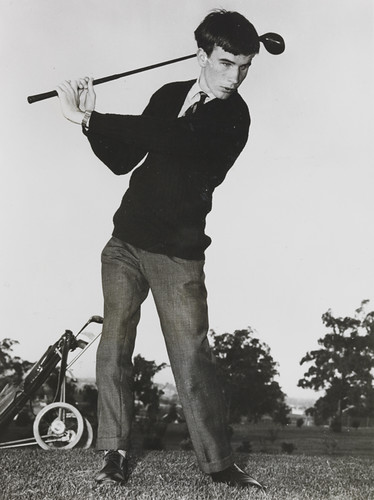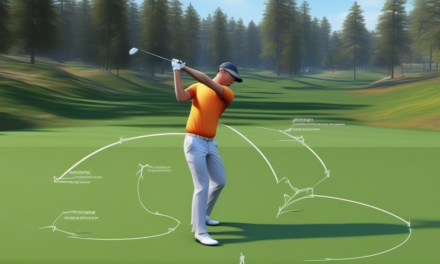
Golf Swing Tips
You’re standing on the green, the sun’s just right, and your heart’s pounding. It’s all down to your swing. Don’t fret! We’ve got golf swing tips that’ll turn those shaky moments into confident triumphs. We’ll navigate the intricacies of grip, posture, alignment, and so much more.
Embrace the challenge, and let’s transform your game together. Remember, every master golfer started somewhere, and with a little guidance, you’re next in line.
TL;DR – Key Takeaways
- Focus on mastering grip techniques and proper alignment/posture for better control and accuracy in the golf swing.
- Pay attention to backswing fundamentals and downswing/impact techniques, such as maintaining a consistent club path and releasing wrists at impact.
- Develop a consistent tempo and rhythm in your swing through practice with a metronome and smooth transitions.
- Understand the importance of club selection and shot shaping skills, as well as balance, weight transfer, follow-through, and mental game for overall improvement in your golf swing.
Golf Swing Tip 1: Grip Techniques
You’re enhancing your control with these grip techniques, bringing a new level of precision to your game. Mastering the golf grip is a crucial step for any amateur golfer looking to improve their swing. It’s not just about holding the golf club; it’s about engaging the right muscles and creating the perfect balance between strength and flexibility.
Here’s a simple golf swing tip: Always maintain pressure in the last three fingers of your left hand (for right-handed players). This helps keep the golf club firmly in your hand during the swing.
Next, remember the ‘V’ position. When you’re gripping the club, the ‘V’ shape formed by your thumb and forefinger should point towards your right shoulder. This ensures optimal control and swing path.
Don’t grip the club too tightly. A tense grip restricts your wrist movement, which can hinder your swing speed and distance. Instead, aim for a grip that’s firm yet relaxed.
Lastly, practice makes perfect. Spend time honing your grip techniques. Over time, you’ll notice a significant difference in your swing’s control and accuracy.
You’re part of the golfing community, and with these tips, you’ll soon start playing like one.
Alignment and Posture
Your body’s alignment and posture at address are as critical as your grip techniques, and they can significantly impact the accuracy and distance of your shots. Proper alignment and posture ensure that you’re ready to execute a powerful and accurate swing, making them important aspects of any golf lesson. They set you up for success before you even start your swing.
Here are some golf swing tips that you can incorporate into your stance during your next practice session:
- Stand with your feet shoulder-width apart for balance
- Align your feet, hips, and shoulders parallel to your target line
- Maintain a straight back but allow for a slight bend at the hips
- Let your arms hang naturally from your shoulders
- Keep your weight evenly distributed on both feet
Remember, golf instruction isn’t one-size-fits-all. What works for one golfer mightn’t work for you. So experiment with these tips, see what feels comfortable and improves your game. With practice and tweaking, you’ll find the right alignment and posture that works for you, helping you feel like a true part of the golfing community.
Enjoy the journey, it’s all part of the game.
Backswing Fundamentals
In the game of golf, mastering the backswing fundamentals is essential for optimal performance, but it’s also crucial to understand the role of timing and rhythm in your swing. As a beginner golfer, you might feel overwhelmed by the amount of advice out there. Don’t worry, you’re not alone.
One of the most effective golf swing tips is to focus on the club’s path during the backswing. Start with your golf club low and slow, keeping it as close to the ground as possible before lifting. This will create a wide arc and a powerful swing.
Furthermore, keep your eye on the ball. It’s an easy habit to let your gaze wander during the backswing, but maintaining focus on the ball ensures a clean contact.
Remember, it’s all about consistency. Practice these backswing fundamentals regularly, and you’ll notice your swing becoming smoother and more powerful over time. Most importantly, don’t rush. Golf is a game of patience and precision.
Embrace these golf swing basics, and you’ll start to feel a sense of belonging on the course. After all, every pro golfer started as a beginner, just like you.
Downswing and Impact
After mastering the backswing, it’s time for you to focus on the downswing and the impact, which are equally crucial to a successful golf swing. Your downswing and impact positions determine the trajectory and distance of your golf ball. These golf swing tips will elevate your game.
Here are a few tips to consider:
- Keep your right elbow close to your body during the downswing. This right elbow position is essential for a controlled swing.
- Release your wrists at the point of impact. This action will increase the speed of the club head, adding distance to your shots.
- Maintain your spine angle throughout the downswing. This helps to ensure a consistent impact position.
- Rotate your hips towards the target during the downswing. It’ll help you generate power.
- Practice your timing. The downswing should be a smooth, unhurried motion, not rushed or forced.
Remember, a good golf swing is a blend of technique and rhythm. Practice these golf swing tips regularly and you’ll notice a substantial improvement in your game.
You’re part of an exclusive club of golfers who understand the importance of the downswing and impact. Keep swinging!
Tempo and Rhythm
You’ll find that a consistent tempo and rhythm play a crucial role in achieving an effective golf swing. Just like a well-conducted orchestra, your swing needs both a steady speed (tempo) and a regular pattern (rhythm) to produce a harmonious performance. This golf tip is often overlooked, but it’s key to ensuring a consistent swing.
One swing tip to help improve your tempo is to practice with a metronome. Start slow, setting the pace to match your ideal swing. As you get comfortable with this rhythm, gradually increase the tempo. This method will help you develop a good golf swing that’s both smooth and powerful.
Rhythm, on the other hand, is about the sequence of your movements. A common mistake is rushing the downswing, which can throw off your balance and timing. To correct this, focus on a smooth transition from the backswing to the downswing, maintaining the same speed throughout.
Club Selection and Shot Shape
Choosing the right club for each shot is a crucial skill you’ll need to master, and it’s equally as important to understand how to shape your shots to navigate the course effectively. The art of club selection and controlling shot shape are essential golf swing tips that every professional golfer swears by.
Having the right golf equipment enhances your ability to execute shots accurately. However, it’s not just about having the best clubs, but knowing when to use which one is crucial. You’re not just playing the course, you’re playing the conditions too.
Here are five tips to help you improve:
- Understand your clubs: Every club in your bag has a purpose, know them.
- Practice shaping shots: Try hitting high, low, fade, and draw shots during practice.
- Learn from others: Watch professional golfers and observe their club selection.
- Use the right club for the right distance: Don’t force a club to do what it’s not designed for.
- Consider the conditions: Wind, terrain, and hole position can affect your club selection.
Balance and Weight Transfer
In the game of golf, it’s not just about the clubs you’re using, but also about mastering balance and weight transfer. Without proper weight shift during your swing, you’ll struggle with consistency and power.
One of the best golf swing tips you can employ is to understand the importance of weight transfer. When you’re preparing for your shot, ensure you’re evenly balanced. As you take your backswing, shift your weight to the inside of your back foot. Then, as you swing through, transfer your weight smoothly to your front foot. This motion should feel natural and fluid, not forced.
There are golf swing exercises that can help you improve this aspect of your golf game. Practice swing drills, focusing on maintaining balance and smoothly transferring your weight. You can use balance boards or even just practice barefoot to really feel the weight shift.
Follow-through and Finish
Don’t just stop after making contact with the ball, but rather follow through to a full finish to ensure maximum power and accuracy in your shot. When we talk about golf swing tips, the importance of a complete follow-through and finish can’t be overstated. It’s the key to a perfect golf swing and a successful golf shot.
Remember, your swing speed doesn’t end at impact. It continues through the swing, and your body should naturally rotate to face the target. This isn’t just about power, but also about control. By maintaining your swing speed through the ball, you’re more likely to maintain the clubface’s alignment, ensuring a straight shot.
Here are some tips to help you with your follow-through and finish:
- Maintain your balance through the swing.
- Allow your body to rotate naturally.
- Don’t force the follow-through, let it happen.
- Practice, practice, practice!
- Stay relaxed and focused on the target.
Mental Game and Visualization

You’re not only working on your physical swing, but also on your mental game and visualization, which are vital for success on the golf course. Much like the pros on the PGA Tour, your mental strength is as important as your physical prowess.
Visualization, a key aspect of the mental game, involves seeing in your mind’s eye the trajectory your ball will take before you even swing. It’s a powerful tool many successful golfers use.
Think about it as a mental rehearsal. You’ve got to visualize the ball’s flight, its landing spot, and the path it’ll take once it hits the ground. It’s like mapping out your strategy before taking action.
Here’s a pro tip: before you take your shot, close your eyes for a moment. Visualize the swing, the impact, and the ball’s flight. Picture it all in as much detail as you can muster. When you open your eyes and execute your swing, you’ll be more likely to achieve the result you visualized.
You’re part of a community that values these golf swing tips. Working on your mental game and visualization will help you feel more connected and make you a better golfer.
Practice Drills and Training Aids
There’s a variety of practice drills and training aids available to help enhance your game, but it’s important to choose the right ones based on your specific needs. As part of our golf community, you’re not alone in this journey. We’re here to provide you with golf swing tips, drills, and aids to help you improve.
Here’s a list of some of the most effective drills and aids that can improve your golf swing:
- Practice your swing with weighted clubs. This can help build muscle memory and improve your swing speed.
- Use alignment rods to ensure you’re aiming correctly and maintaining proper posture.
- Invest in a swing analyzer tool. These gadgets provide real-time feedback on your swing technique.
- Putting mats can help you practice your short game at home.
- Lastly, don’t underestimate the power of online resources. There are plenty of free online golf tips that can provide valuable insights.
Frequently Asked Questions
What Type of Golf Shoes Provide the Best Support for My Swing?
You’re seeking shoes with top-notch swing support. Opt for spiked golf shoes. They’ll give you stability and traction, critical in maintaining balance and power in your swing. Remember, comfort’s vital for optimal performance.
How Do Weather Conditions Like Wind or Rain Affect My Golf Swing?
Wind and rain can drastically impact your swing. Strong winds can shift your ball’s trajectory while rain can affect grip and footing. Adjust your swing and stance to counter these weather conditions. Stay focused, you’ve got this!
What Is the Best Time of Day to Practice My Golf Swing for Optimal Performance?
You’re in luck! Early morning or late afternoon is ideal for practicing your swing. Cooler temperatures help maintain focus, while softer light provides less glare. Remember, consistency is key to improving your golf game.
How Can I Prevent Common Golf Injuries When Swinging?
To prevent common golf injuries when swinging, you’ve got to warm up properly, maintain good posture, and avoid over-swinging. Try focusing on technique rather than power. Remember, it’s a swing, not a hit.
How Does Varying Club Length Affect the Dynamics of a Golf Swing?
Varying club length changes your golf swing’s dynamics. Longer clubs increase swing speed but decrease control. You’ll need to adjust your stance and grip for each club length to maintain balance and accuracy.
Conclusion
In the grand tapestry of golf, each swing is a unique stitch. Your grip, alignment, backswing, and downswing are the threads that weave your game.
The tempo sets the rhythm, while balance and weight transfer create the pattern. Follow-through and mental visualization are the finishing touches.
Practice drills are the needle, constantly refining your craft. Remember, no masterpiece was created overnight.
Keep practicing, keep visualizing, and soon, you’ll have a golf game that’s a work of art.





